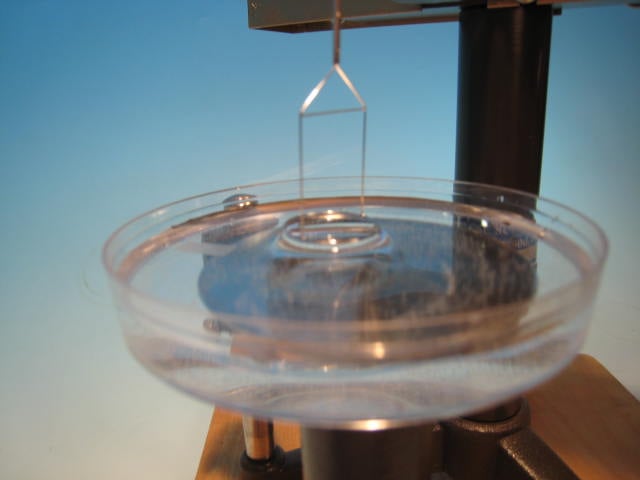I was musing, the other day on the designs of two ring tensiometers. One of them is called an interfacial tensiometer
One of them is referred to as a plain tensiometer, which operates solely with an upward pull, while the other is known as an interfacial tensiometer, capable of both upward pull and downward push. Before delving into my inquiry, let's establish a few definitions.
Surface tension is the intriguing property of a liquid's surface that bestows it with plastic-like characteristics. It's the reason why an insect can effortlessly stroll on the surface of a pond or pool.
Temperature Sensitivity
Consider the surface tension of water when exposed to air as a typical example. At room temperature, water exhibits a surface tension force of approximately 70 dynes per centimeter. When water reaches its freezing point, the surface tension approaches infinity, while nearing boiling point, the surface tension decreases towards zero.
Utilizing a Ring for Measurement
One method to determine the surface tension of a liquid involves using a platinum ring. By pulling the ring through the liquid's surface, the liquid adheres to the ring above the surface. The force required to break the liquid away is then measured and converted into surface tension.
Interfacial Tension Between Different Liquids
The same physics and chemistry that create surface tension also establish a distinct interface between two immiscible liquids, leading to interfacial tension. This interfacial tension acts as a barrier preventing one liquid from invading the surface of another.
Measuring Interfacial Tension
When measuring interfacial surface tension, such as between water and oil, a platinum ring is utilized. The ring is pulled through the surface of the water into the oil, with the water adhering to the ring. The force upon detachment is measured and converted into interfacial surface tension.
In an older publication titled "An Interfacial Tensiometer For Universal Use," the necessity for both upward pull (water to oil) and downward push (oil to water) was highlighted.
I scoured through a plethora of interfacial tension resources to uncover the significance of downward movement, like from oil to water, but found no concrete application.
Do You Require Downward Measurement?
I am eager to learn about the potential applications of downward measurement and the distinction between upward and downward interfacial tension. If you have any insights on this, feel free to comment on this post or email me at cjang@cscscientific.com.
Cho
Interested in Subscribing? All you have to do is insert your email address into the box just to the right of the title.


